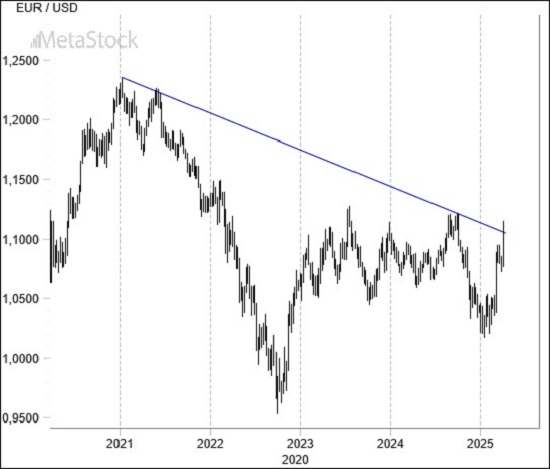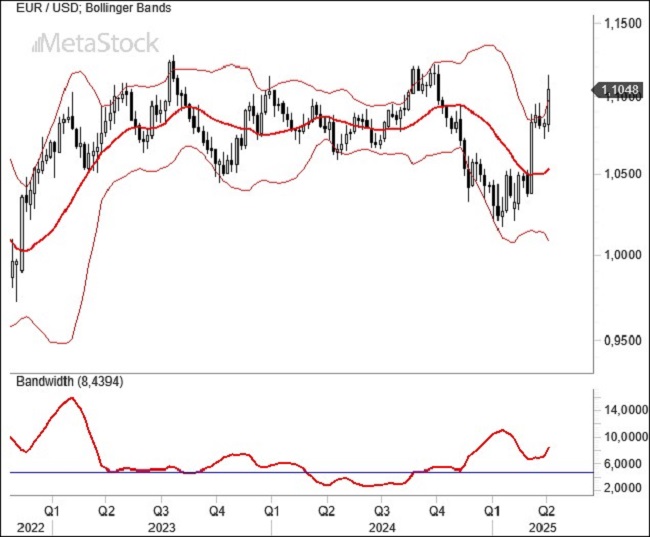- Trump’s tariffs shake up global trade, pushing the world to find new equilibrium in the face of barriers that will slow growth and reignite inflation. All US assets, except for bonds, take a hit.
- Europe reacts to Trump’s measures by announcing countermeasures, while China steps up to the plate, retaliating with tariffs of equal scale on American goods. Short-term interest rates fall, hinting at a possible rate cut from the ECB.
- EUR/USD pushes again toward the 1.10 mark, signaling what could be a final assault on 1.12, the last stronghold before a potentially stronger bull market for the euro.
Trump’s Tariffs Spark Global Trade War and Economic Uncertainty
The day of reckoning has arrived. Or rather, the day of liberation. But also, the day of surrender, judging by the markets’ reaction. As promised during his campaign, Trump shook the world with his decision to impose tariffs on imports from numerous countries, starting with a base rate of 10% (for instance, the UK) and escalating progressively based on the US’s trade deficits with those countries. For the EU, tariffs will be set at 20%, for China at 34%, and for other Asian countries like Vietnam and Cambodia, they will approach 50%. The 25% tariffs on Canada and Mexico remain in place, along with all tariffs already imposed on steel, aluminum, and the automotive sector.
The American president thus triggers a trade war, offering a few days for countries to negotiate. Meanwhile, we can expect swift and firm countermeasures from the affected nations (such as China), with the risk of a global inflationary surge making a comeback after being tamed.
This unfolds against a macroeconomic backdrop in the US, where the services sector has held up but manufacturing has been struggling for some time, raising concerns of stagflation. The ISM index recently dropped below 50 points, with the price component spiking to its highest since June 2022. It’s not difficult to predict that, with tariffs in place, things may worsen further.
Meanwhile, European interest rates continue to edge lower, aided by an inflation rate that dropped to 2.2% in February, with core inflation at 2.4%. Service-sector inflation is at 3.4%, its lowest since June 2022.
The market isn’t fully convinced that the ECB will cut rates at its April 17 meeting, but with the tariff uncertainty removed and the Eurozone’s manufacturing PMIs below 50, another cut seems likely. All eyes are now on the EU’s retaliation measures against the US.
Technical Analysis: EUR/USD Targets 1.12 as Volatility Surges
The nearly 2% jump in EUR/USD after Trump’s announcement clearly reflects the market’s view on this new trade strategy from the White House. The dollar will depreciate for several reasons: it’s the fastest way to address a deficit, long-term interest rates will fall due to expectations of slower economic growth, and yield differentials with other countries will shrink.
EUR/USD is now eyeing a renewed attack on the 1.10 level, and this time, a break above 1.12 seems increasingly probable. Once that threshold is crossed, the euro will face the downtrend line that has guided its decline since 2020. Surpassing this level would open the door to even grimmer prospects for the greenback.

Volatility in EUR/USD surged following Trump’s announcement, as expected. However, since early March, the pair has been moving more erratically upwards, with the Bollinger Bands now showing wider extremes, signaling that we could see further increases in the coming weeks. A move toward the upper band would confirm the start of a new bullish trend.



Leave a Reply
You must be logged in to post a comment.